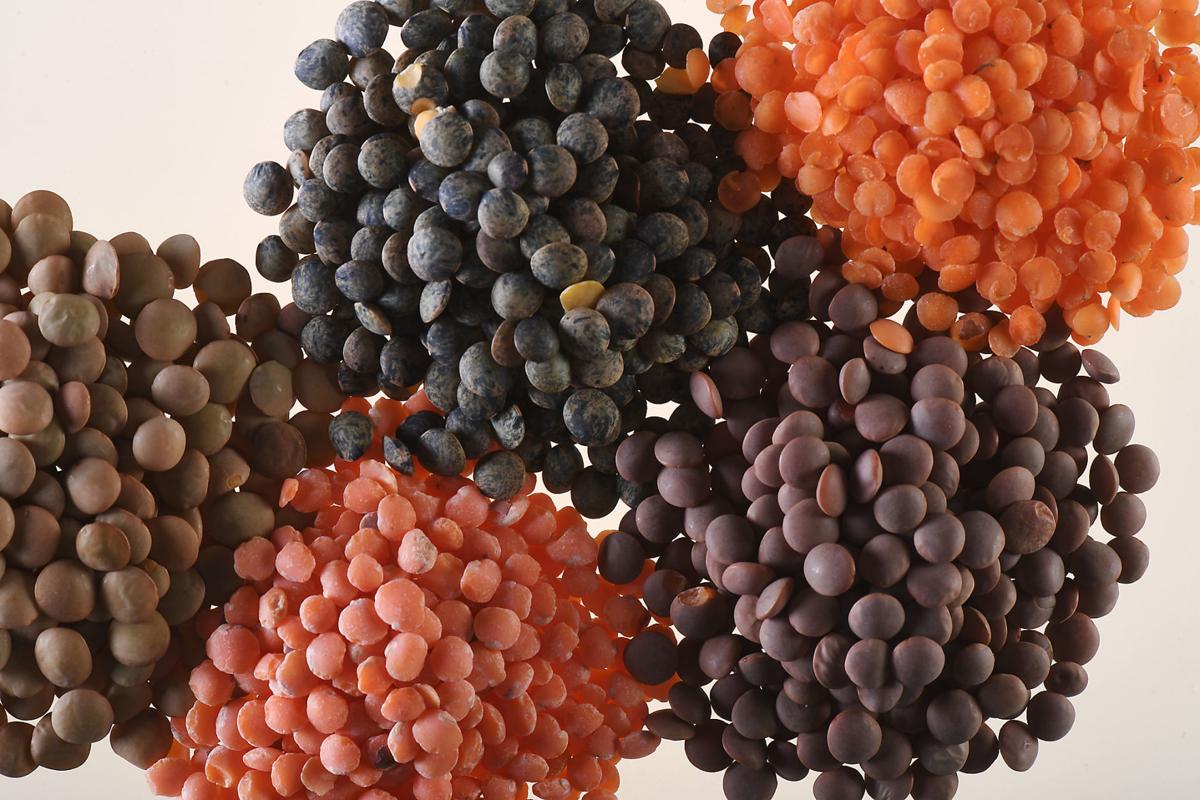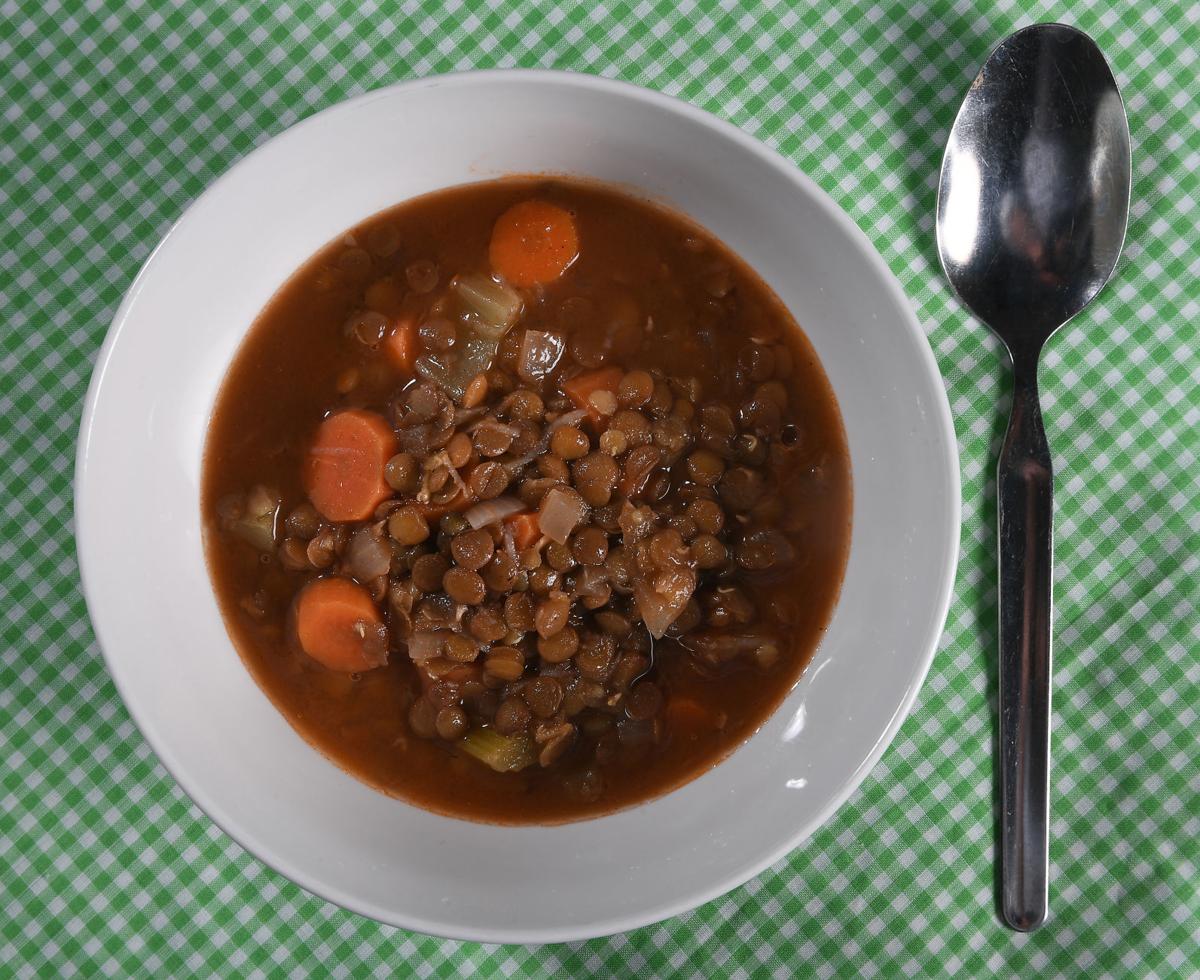By HEATHER LARSON POYNER hpoyner@kenoshanews.com
Heather Poyner
16 hrs ago

This colorful assortment includes, clockwise from top center: French lentils, split red lentils, masoor red lentils, whole red lentils and green lentils.
KENOSHA NEWS PHOTO BY BILL SIEL

Mediterranean Lentil Soup
KENOSHA NEWS PHOTO BY BILL SIEL
Somewhere on the lower levels of the shelves in the dry bean aisle of the grocery story, lentils are lying in wait.
They are waiting to be discovered — or at least more widely recognized — as the flavorful, versatile and nutritious food they are.
Once known as “poor person’s food,” lentils are growing into an “it food” among foodies, vegetarians, vegans and flexitarians (those who are primarily vegetarian but choose to eat meat occasionally). One variety, the French Le Puy lentil, even comes with a “stamp of authenticity” on an artfully designed package.
In the past year, lentils have grown to become one of my personal favorite foods as an ingredient and as a stand-alone star.
I began by checking out recipes relying less on meat and more on plant proteins and was drawn to exotic-sounding dishes found in “Forks Over Knives” (Del Sroufe, 2012). These included Red Lentil Soup, Ethiopian Lentil Stew and Minty-Lemon Lentils with Spinach.
Exploring these recipes, I found that as well as offering flavor and texture, lentils are quite easy to work with.
I discovered that lentils are packed with protein as well as other nutrients, but I also discovered that some of my friends and colleagues were not in the know about their amazing qualities.
I took pity on the poor lentils and wanted to sing their praises.
Seeking experts on the matter, I found the USA Dry Pea & Lentil Council, based in Moscow, Idaho. Jeff Rumney, the council’s vice president of marketing, confirmed that lentil consumption and knowledge is much higher in other countries.
Lentils are “a very old food” and one that can grow all over the world, Rumney said. Many cultures incorporate lentils into their diets, ground into flour or eaten whole. “In Sri Lanka they eat lentils 21 times a week — for breakfast, lunch and dinner,” Rumney said.
Lentils are part of the legume family but belong more specifically to the branch known as pulses, which also includes dry peas, beans and chickpeas. Low in fat and high in protein, lentils and other pulses have been an energy food for many cultures over time.
Plentiful, cheap and nutritious, lentils and their other legume cousins have been staple foods for people with limited food resources.
“In literature, proverbs and songs they are constantly referred to as ‘food of the poor’....They have even been included as such in the Kitab al Buhala (Book of Misers),” writes Claudia Roden in her 1968 work, “A Book of Middle Eastern Food.”
In the U.S., lentil production began in Idaho by early settlers of the Seventh Day Adventist church. As vegetarians, they cultivated lentils as a nutrient-dense food source. Today, Montana and North Dakota are the largest lentil-cultivating states.
We do not consume most of the lentils grown here, Rumney said. “Eighty percent of the lentils grown in the U.S. are exported to other countries.”
To increase awareness on pulse foods, the USA Dry Pea & Lentil Council has become affiliated with the American Pulse Association. Its website, pulses.org, provides a comprehensive overview of each of the pulse foods as well as recipes and cooking tips.
They have identified three challenges American cooks perceive about lentils, said Rumney. These are: lentils are considered hard to make; consumers may not know what to make with them; and they are perceived to cause “gastric distress.”
Addressing the last point, Rumney noted that gastric distress usually occurs when a person consumes larger portions of beans infrequently. The solution is to eat smaller portions more often, possibly a half-cup of pulse foods every day. “You don’t reinvent the recipes; simply add them to existing recipes.”
Locally, some are already fans. “Lentils are probably one of my favorite legumes!” exudes Kenosha resident and nutritionist Laura Cox. “They are packed with protein and fiber. A half cup of cooked lentils has about 12 grams of protein and 9 grams of fiber (about three times that of brown rice).”
A practitioner of Natural Functional Medicine and owner of Acupuncture & Wellness of Wisconsin, Cox noted that lentils also contain key nutrients including calcium, iron, potassium and folate.
These benefits, plus being low-fat, make lentils a go-to for athletes, pregnant women, vegans and vegetarians, Cox said.
“Lentils also have a low glycemic index, which helps people feel satisfied for longer,” Rumney said.
Lentils are a real rainbow food; while green, brown and red are varieties most commonly carried by grocers, ethnically specific grocery aisles may also offer Italian black lentils, French lentils and whole red lentils from India known as “masoor.”
In a taste-test, this reporter discovered that most lentil colors taste similarly mild, making them amenable to taking on flavors of the dish they are in. The exception is medium-size green lentils, which have a faint peppery note.
The choice of which lentil to use comes down to desired texture. Split red lentils, which present as more orange than red, are smaller than brown or green lentils, take less time to cook and break down rapidly. This makes them amenable for dishes like stews for which a paste-like consistency is desirable.
Conversely, choose the green or brown lentils in recipes for which the whole bean is preferred, such as a cold salad.
Unlike most beans, lentils do not need to be soaked before cooking; reds cook in 20 minutes, whereas brown and green lentils make take one to three hours to cook. Variability depends on where they were grown and how long they have been dried. As cooks are not generally privy to these specifics, it is best to follow a conservative cooking times, tasting along the way.
“I use all varieties, but I typically go for green or brown because they have a smoother texture, which I love,” Cox said. “Red lentils tend to be a little nuttier and I like them better ‘al dente’ so they have more chewiness to them.”
If all of this doesn’t sell you on lentils, consider these ruminations from Rumney:
“Lentils in the field are the most humble and unassuming crop you’d ever want to grow. They sit fairly low to the ground and are ‘non-competitive’ with other plants.”
He added, “Lentils grow in tiny pods with only two or three kernels per pod....Farmers who grow lentils are the best farmers, because lentils are harder to grow.”
No comments:
Post a Comment